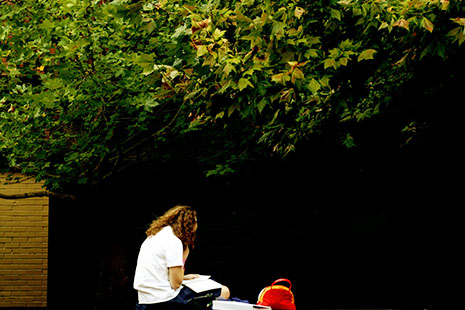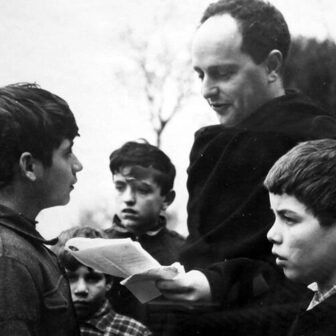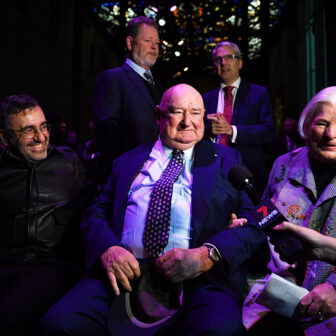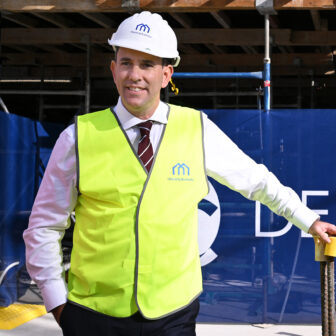JENNIFER sits poised on the edge of a large leather armchair, one of several plush lounges decorating the expansive lobby of the high-rise building where she works in Melbourne’s CBD. She is composed and smartly dressed. If she’s nervous about sharing the intimate details of her life with a stranger, she shows no sign of it.
She speaks quietly and surely, describing the ups and downs that have shaped her first twenty-one years, and her ambitions to move up the ladder at the call centre where she has worked for the past three years. Eventually, she hopes to establish an IT business with her boyfriend.
“If you see your parents working hard and struggling when you’re growing up, it helps you realise that you do need to work hard to support yourself,” Jennifer says. “That’s why I’m the way I am. I’ve been financially independent since I was fifteen and I started working. I’ve never asked my parents for money since then. A lot of my friends don’t understand that I’ve always wanted to work and support myself.”
Some young people might have been derailed by the events that life has already thrown Jennifer’s way – her father’s bankruptcy when she was a young girl, the separation of her parents, the tough times her mother had bringing up five children. But Jennifer sees her early experiences in a largely positive light, recognising that they contributed to her independence and maturity.
She stresses that many contemporaries have known worse, and cites the Life Chances study, a research project tracking the experiences of children born in inner Melbourne during a six-month period in 1990. The study began with the mothers of 167 babies, and the most recent findings – just released by the Brotherhood of St Laurence, or BSL – paint a rich and complex portrait of the study’s “babies” at age twenty-one.
The findings may not be representative of wider Australia – the subjects were sourced from two suburbs that are unusual in having high concentrations of both low- and high-income earners – but they provide a fascinating study in contrasts. They illuminate the differences, and some similarities, between those whose parents are refugees, unskilled workers, or unemployed, and those whose parents are doctors, academics and other well-to-do professionals. (The researchers ask that the suburbs not be named to protect the privacy of their subjects, given the large amount of personal detail revealed in the study’s reports.)
Tim Gilley, who helped establish the study but now works in education research and teaching at Melbourne University, says the contrast between the study’s subjects is what makes the findings so powerful. “It raises the question, if something is good for these [wealthy] children, why isn’t it available for all children?”
While many families have been on the move over the years – only one-fifth still live in the suburbs where the study began – there has been less social and economic mobility. About half are in the same income bracket as they were at the start of the study, 37 per cent have improved their position, and 14 per cent are now worse off financially.
One reason Jennifer has been such an avid reader of the study’s findings is that they record something of her own family’s history. She began to take an interest from when she was about twelve, and says its reports have made her conscious of the positives in her life. “They showed us what other people had been through. Some people have lost their parents, some are homeless,” she says. “That made me appreciate the fact that I do have a family and a house; that even though we don’t have the money, we still do have some things.”
The importance of growing up in a close-knit family is a recurring theme for Jennifer, who says, “I definitely want my own family like that.” She puts more emphasis on family and relationships than material success, and says the earthquakes in Japan and New Zealand and the 11 September 2001 attacks on the United States have had a lasting impact. “Those made me aware of what can happen and to expect the unexpected – so to appreciate the time you do have with people that you care about.”
Jennifer acknowledges, however, that responsibility to family can have a downside. She and her siblings help support their mother financially, and “It does feel like a burden sometimes,” she says. “I do think, ‘We’re the children, she should be taking care of us,’ but we have all found our own jobs, so we’re supposed to give something back to her.”
As well as helping pay her mother’s debts, Jennifer is repaying a $35,000 debt incurred when she was eighteen and crashed a hire car. No one was hurt, but the accident changed the course of her life. Only afterwards did she realise she hadn’t been insured to drive the car. She gave up university to get a job to repay the debt, and says she probably would have stayed at university if not for the crash.
But the accident was her fault, she says, and she has no regrets: “The car accident was a big part of me growing up. It’s helped me gain a lot of responsibility; it was a bad situation but there was a positive outcome out of it.” One of the only regrets that Jennifer expresses during our conversation is that she didn’t spend more time with her grandparents in the United States before they died. “When I was younger,” she says, “I didn’t realise how important it would be to go and visit them.”
It’s impossible not to be impressed by Jennifer, especially for those of us who don’t find anyone nearly so thoughtful or mature when we look back to ourselves at her age. But is she typical of twenty-one-year-old Australians?
A clear message from the study is that searching for stereotypes about young people is foolish. Their lives are diverse, and not always predictable from their early circumstances. The 123 young people (out of the original 167) whose experiences help inform the latest Life Chances report don’t even agree on whether, at age twenty-one, they are grown up. Only 38 per cent said they would describe themselves as adults; 13 per cent said they were not yet adults and 49 per cent answered “yes and no.”
Tellingly, there are marked differences according to their backgrounds. Those from well-to-do families are far less likely to consider themselves as adults, compared with those from lower- and middle-income families. They are also far more likely to be living at home. Eighty per cent of those from well-to-do families receive financial help from their parents, compared with 20 per cent of those from low-income families. Those from families in which English was not the first language are also far less likely to receive financial help from their parents.
While most twenty-one-year-olds are studying or working, some already show the mark of poor health. Fourteen per cent said they had long-term health problems or disability (anxiety and depression being the most common conditions mentioned), with almost one in five saying they had experienced mental health problems during the year they turned twenty-one. Four people – all of whom had grown up in low-income, single-parent families that had experienced multiple forms of disadvantage – had taken on the role of caring for their own parents. Of the 123 young adults, five are now parents themselves.
IN RETROSPECT, 1990 was quite a year. The Cold War was thawing; Germany was reunifying; Soviet leader Mikhail Gorbachev was awarded the Nobel Peace Prize. Iraq invaded Kuwait and Nelson Mandela was released from prison. It was also the year when poverty was to have been banished from the lives of Australian children – if Bob Hawke’s (later regretted) 1987 election promise had been kept.
But often the significance of historical events only becomes apparent with the passage of time. The young people born in 1990 tend to see their present circumstances as the result of their own choices, without necessarily recognising the impact of wider events or forces, whether it’s a tight housing supply, changing demographics, economic crunches or world events. It is only towards the end of our conversation that Jennifer mentions that her parents are Chinese and came to Australia from Vietnam thirteen years before she was born. When I enquire further, she is vague about whether they were refugees, but then says they were. She doesn’t know a lot about their history, she explains. “They don’t really talk about it much,” she says. “They don’t want us to live off their life experiences. They want us to live off our own.”
But the study’s reports make it clear that the individual stories – like the factory worker whose job loss sent his family into a downwards spiral and the young people who struggle with part-time, insecure jobs – are also shaped by wider narratives such as changes in the economy and labour market. While the study write-up describes how “structural inequalities of income, ethnicity and gender” influence young people’s experiences, most of the study’s subjects are quite positive about their early lives, often seeing good in what might be judged as hard times.
Whether they grew up rich or poor, mostly they say their family’s economic situation did not affect them. Even those who do recognise an impact tend to see it in a positive light – for example, that it taught them to be independent or to manage money. The researchers see this as reflecting “both the need to put a good face on one’s life story and the optimism of young people starting their lives as increasingly independent adults.”
Nonetheless, the study findings make it clear that financial constraints have had a very real impact, particularly on the children’s access to education and healthcare. Parents from all income groups valued education, but the costs of a supposedly free public school system imposed hardship on many, reducing their capacity to support their children’s education. By age eighteen, a quarter of children from lowincome families had left school early, but none from high-income families had done so. As a previous report from the BSL puts it, “the education system in many ways serves to maintain social divisions across the generations” – an observation that is particularly pertinent given recent state government education funding cuts.
Some children from poorer backgrounds did very well at school. “This raises the challenge of predicting early school leaving from early indicators, and of finding ways to acknowledge both the impact of disadvantage and the resilience of young people in a way that avoids unhelpful stereotypes,” write the researchers. “Our findings suggest the importance of all schools being well resourced to provide extra support at all ages for students with language and learning difficulties, but also to provide a context which does not label certain groups as low performers. The young people experienced very different learning environments, not only in government and non-government sectors, but also in differently resourced government schools.”
According to Michael Horn, a senior manager in the BSL’s research and policy centre, one of the study’s important messages is the need for Gonskistyle reforms to direct more resources towards the most needy children, particularly those from the 5 per cent of families experiencing multiple layers of disadvantage.
“For the foundational issues like education, adequate income, affordable housing, these foundational building blocks need to be addressed with strong universal services, which we currently don’t have,” says Horn. “You also need to target, ideally in an early intervention way, those students experiencing disadvantage beyond the school gate. We need to do more to prevent that group of kids who struggle from dropping out of school.”
Alan Hayes, director of the Australian Institute of Family Studies, has taken a close interest in the Life Chances findings over the years – not least because he also has a child born in 1990. While it may not be as large or representative as other longitudinal studies, he says its in-depth interviews provide rich insights into the diversity of children’s lives and the unpredictability of their pathways through childhood and into adulthood.
“What gives me heart out of the Life Chances study is that some of the children who looked most compromised have remarkable capacities to recover, and part of that resilience comes from those around them and the opportunities they are given,” he says. “Today we can be a bit precious about the capacity of children to adapt and recover.”
Hayes says the findings also reinforce the importance of providing better support to children and families at all stages of development, particularly the middle childhood and the critical years of ten to fifteen, and not only during early childhood. “That’s what Life Chances and other studies show you – how there are many important windows along the way where things can be changed for good or for ill.”
Hayes cautions against placing too much emphasis on the Jesuit maxim about the enduring influence of the first seven years of life – and warns against labelling children if they’ve had a tough start. “Sometimes, it can become a self-fulfilling prophecy in a dangerous way if we change the way we interact with these kids,” he says.
BACK in the late 1980s, when they were lobbying for support for the Life Chances study, the far-sighted researchers hosted screenings of the famous Seven Up! documentary series, which has followed a small group of British children since they turned seven in 1964.
Now some of the Life Chances children feature in an educational DVD that captures glimpses of them at ages thirteen and eighteen. While there are funny moments – as when thirteen-year-old Bernard says, “I don’t really look forward to going to school but it’s better than going to the dentist” – the main impression it leaves is a sadness that some children miss out on so many of the chances available to others.
Even so, money can’t solve every problem. William may enjoy every opportunity available to a privileged white boy, but at thirteen it’s clear in the documentary that he just wanted more time with his father. He says, poignantly, “Money isn’t the most important thing in life and I realise we are really lucky because we’ve got quite a lot of it. I’d rather have not as much money and spend a lot more time with my dad.” William’s father, meanwhile, tells us that he never wanted to be like his own father, working long hours, but adds, “I don’t see much of my own children at all.”
Five years later, the concern still weighs on William as he considers whether to study medicine and follow in his father’s footsteps. “I have always just thought that I don’t want to work as hard as Dad does,” he says. “He works very hard to afford the lifestyle that we keep but it comes at a cost of not seeing him as much, but it also has its benefits, we have the opportunity to give back to the community.”
The film also introduces us to the musically talented Oscar, who shows impressive motivation despite a series of seemingly insurmountable obstacles – on top of having no job, no transport and no significant qualifications, he is socially and geographically isolated. He seems determined to create a future, however, and is set on getting a driver’s licence so he can find an apprenticeship.
I watch the film with a friend, Daniel Clements, who has worked with disadvantaged youth for many years. He is impressed by how it lets us hear the voices of the young people (something that the study’s reports suggest agencies like Centrelink and schools often fail to do). “The natural strength of the kids’ voices comes out,” says Daniel, “from the anxieties to the optimism.”
That contrast also strikes Janet Taylor, a researcher on the project since its conception. She says that twenty-one is an age of both anxiety and anticipation, citing one man who spoke of the “quarter-life crisis” but also saw the twenties as “the golden years.” Taylor says many young people worry about studies and job opportunities, and that their lives are completely different from when she was their age. “When I went to uni, there was definitely a job at the end, or at the end of school,” she says. The years do not seem to have dimmed Taylor’s passion for her work; when we meet one morning in a cafe near her office in Fitzroy, her gestures are intense and her eyes alight as she describes the families whose stories she has come to know so well, and what might help improve their lives.
She says that there needs to be a rethinking of policies built on the assumption that young people follow a linear transition from school to higher education or training to employment. These days, for many, the journey is more one of stops, starts and backward steps.
While Taylor is delighted by the resilience of some of the young people, she worries about others, including those young men who left school early with learning and/or behaviour problems and possible mental health issues, don’t seem to have found a niche in life, and have not been engaged in any meaningful way by support services.
“The government’s ‘earn or learn’ policy does not seem to usefully reach these young men,” she says. “I also have concerns about the isolation of a couple of the young mothers in public housing who don’t feel they have friends. And while here I am talking about a few individuals, we know that there will be a much larger number of young people in the wider community facing similar issues.” Taylor nominates housing and the need for youth-friendly mental health services as two other critical areas requiring more policy attention.
Tim Gilley also stresses the importance of housing policy to wider societal wellbeing. “If housing wasn’t so expensive, people would have more resources,” he says. “Housing has an enormous, distorting effect on where people live, go to work, on quality of life and stresses that affect children.”
Any number of reports and inquiries have shown the impact of disadvantage on health and wellbeing. Recent examples include an ACTU inquiry into insecure work; a report from the Australian Social Inclusion Board which revealed that 33 per cent of Australians in the lowest income group experience fair or poor health, compared with 6.5 per cent of those in the highest income group; and a report from the COAG Reform Council showing significant inequities in both health outcomes and access to health services.
What Life Chances adds to statistics like these is the power of storytelling, says Taylor. She and her colleague Malita Allan hope the study will focus more attention on the often-untold stories of those experiencing hardship. Says Allan: “I do think the story of these kids growing up, missing out on school excursions, textbooks etc, just goes unnoticed.” Taylor agrees. “By trying to tell some of the young people’s stories and the families’ stories from their perspective,” she says, “we hope to give people in our wider society more understanding of what some members of the society are going through.”
WHEN the latest Life Chances survey arrived at Lucienne’s family home, her mother wasn’t keen to continue sharing the family’s details. But Lucienne insisted she complete the form. “I was like, ‘You have to do it,’” she says. “It’s extremely important because I’m studying psychology and I really believe in the benefits of longitudinal studies.”
Lucienne, who is thoughtful and articulate, has had plenty of life chances – both parents are professionals and she enjoys good relationships with them and her younger sister. Her parents have been very supportive, helping her financially when she moved out of home and taking the family on many overseas trips.
Only after we’ve been talking for some time does it emerge that there was a time she hated school so much that she wanted to drop out. She was bullied and felt excluded, both at primary and at high school. “I didn’t fit in,” she says. “I was kind of a ratty kid. I wanted to be a writer and a musician and didn’t want to waste any more time studying.”
Her attitude changed towards the end of Year 8, when she started going out with a boy who was academically inclined. “I needed to impress this guy so I decided I wanted to take school a bit more seriously,” she says. “I don’t even know if I would have graduated if I hadn’t have met him.” Eight years later, the pair are saving so they can travel overseas when uni is finished.
Looking back, Lucienne feels her difficult times at school led to her interest in psychology and, if she could go back in time, she would reassure her fifteen-year-old self that “life gets better.” “I think I wanted to be the school counsellor,” she says, “and sit in that room and talk to me and say it’s going to be better when you get to uni.”
Back in the high-rise lobby, Jennifer’s childhood experiences seem worlds away from Lucienne’s. But she also had to deal with tough times at school – suffering exclusion because of her Chinese appearance. “It definitely made me feel left out,” she says. It was a relief to leave school and find less discrimination in the workplace.
While Jennifer stresses that she doesn’t let racism bother her, it clearly has had an impact. “Even though people try to overlook it and say Australia is multicultural, in truth there are a lot of racist people and it’s hard, it’s really hard,” she says. “I’ve grown up here my whole life… Some people treat me very poorly because they don’t think I belong here.” When I ask her what she would like to see flow from the study, Jennifer says a greater acceptance and understanding of diversity, and a “society that helps everyone.”
What Jennifer has learnt in her first twenty-one years is, to some extent, what the researchers have learnt from the study at this landmark stage in its history. “It’s about, what sort of society do we want to live in?” says Janet Taylor. “As a society, how can we give all our kids every opportunity?” •
• Details of the Life Chances reports and the DVD, Life Chances: Turning 13, Turning 18, are on the Brotherhood of St Laurence’s website. The Bokhara Foundation and the Prue Myer Fund helped fund the recent stages of the study.
• This article was jointly funded by Inside Story and Australian Policy Online.




